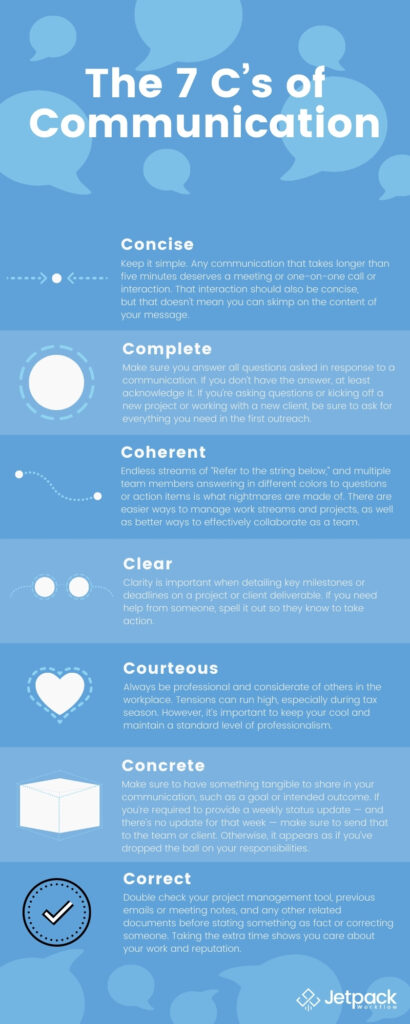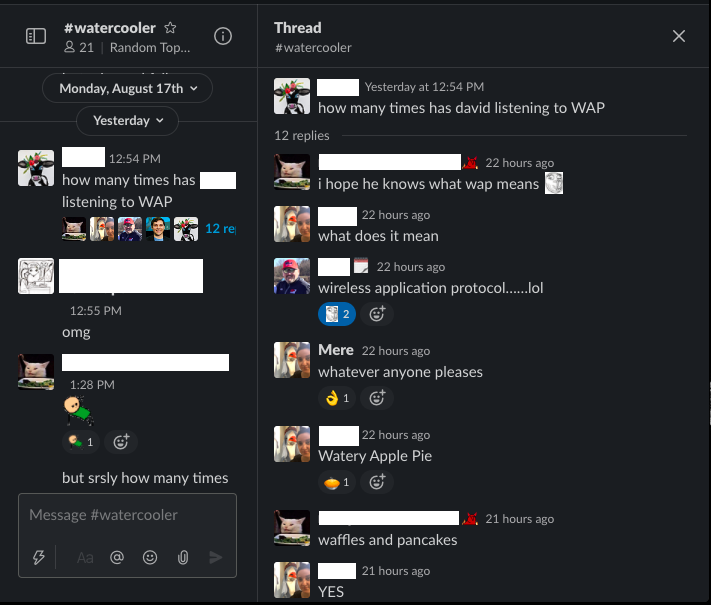How to Create a Culture of Effective Communication in Your Firm

And just like that, Summer is over. It went fast, didn’t it?
Even though your vacation time looks different this year, the time away will hopefully afford you and your team a much-needed time to relax and reconnect with family.
Unfortunately, missing a business day can have cascading impacts on workflows, resource management, and communication overload from your inbox that only reaches zero for moments at a time. On one hand you have too much communication with the outside world, but on the other hand you don’t have all of the pieces you need to get your work done and grow your firm.
Wouldn’t it be great if your inbox was filled only with actionable and useful information?
As most of us have been working remotely for nearly six months now, the reliance on technology is real and not going away anytime soon.
Why Good Communication at Work is Important
In today’s workplace, it isn’t enough to have good presentation skills or perform well in a staff meeting. The action of doing work involves many technologies, platforms, and programs. And when working in a collaborative work environment, there are many teams and personalities to consider.
Communication is defined by the exchanging of information. This information can be assigning work to someone, updating a client on the status of their tax filings, or asking your team members about their workload. And there are a number of ways you can communicate, both in format and medium.
What Are the Different Types of Communication?
There are five types of communication. Understanding these types within the workplace can be a critical first step in ensuring effective communication permeates your firm and energizes your team to do their best work.
1. Verbal communication can include face-to-face conversations or virtual meetings or events on Zoom, Skype, Microsoft Teams, or Google Meet. Communication shouldn’t be confused with formal communication. Remember to consider how you communicate with team members in the breakroom, by the copier, or running for the elevator.
Factors to consider: Tone of voice, volume, and speed.
2. Non-verbal communication refers to the non-verbal cues we send or receive through body language or facial expressions. Crossing your arms or looking down at your phone or laptop during a meeting implies that you aren’t open to collaborating or think the subject matter isn’t relevant or important.
Factors to consider: Facial expressions, eye contact, position of hands and arms, body mirroring, and posture.
3. Listening includes audio communication via phone call, podcast, webinar, or audio-only recordings. Things to consider for this form of communication are similar to verbal communication with an emphasis on the receiver instead of the bearer of the information. Active listening is a crucial part of effective communication skills.
Factors to consider: Free of distractions, focused attention, repeating for understanding, and asking or answering questions.
4. Visual communication includes anything that a person must look at to absorb and retain information, such as social media posts, memes, GIFs, graphs, charts, or branding for internal promotions or memos.
Factors to consider: Format or medium, use of color or other graphical elements, technical considerations, and timing.
5. Written communication is a big part of communication in the workplace today. This type includes anything an employee would read, including email, instant messages, website pages, slide presentations, reports or memos, newsletter, job descriptions, performance reviews, or an internal intranet or hub.
Factors to consider: Format or medium, organization of content, technical (if digital), timing of message, and context in which the message or communication is launched.
Here’s a quick cheat sheet you can share with your team or other managers in your firm:
The 7 C’s of Communication
1. Concise
Keep it simple. Any communication that takes longer than five minutes deserves a meeting or one-on-one call or interaction. That interaction should also be concise, but that doesn’t mean you can skimp on the content of your message.
2. Complete
Make sure you answer all questions asked in response to a communication. If you don’t have the answer, at least acknowledge it. If you’re asking questions or kicking off a new project or working with a new client, be sure to ask for everything you need in the first outreach.
3. Coherent
Endless streams of “Refer to the string below,” and multiple team members answering in different colors to questions or action items is what nightmares are made of. There are easier ways to manage work streams and projects, as well as better ways to effectively collaborate as a team.
4. Clear
Clarity is important when detailing key milestones or deadlines on a project or client deliverable. If you need help from someone, spell it out so they know to take action.
5. Courteous
Always be professional and considerate of others in the workplace. Tensions can run high, especially during tax season. However, it’s important to keep your cool and maintain a standard level of professionalism.
6. Concrete
Make sure to have something tangible to share in your communication, such as a goal or intended outcome. For example: If you’re required to provide weekly status reports — and there’s no update for that week — make sure to send that to the team or client. Otherwise, it appears as if you’ve dropped the ball on your responsibilities.
7. Correct
Double check your project management tool, previous emails or meeting notes, and any other related documents before stating something as fact or correcting someone. Taking the extra time shows you care about your work and reputation.

Setting Up Your Team for Success with Digital Communication Best Practices
We’re giving digital communications its own section, because the nuances run deep when it comes to effectively communicating across multiple platforms and with multiple team members. You can feel the tension in emails that end with “Please advise,” and you know your team can too.
From endless email strings and back-to-back Zoom calls, you and your team may wonder if technology actually helps to make working easier. And with increasingly more ways to contact a team member, a poorly-timed chat message can cause even the shyest employee to bristle under the pressure of an ill-managed work environment.
Smoothing out the ruffles between teammates is a talent in which great managers excel, so let’s take a look at a few best practices to get you there:
Email leaves a lot to be desired in the modern workplace. Inbox zero is a goal of yours, just like you hope to one day take a lunch away from your laptop and not return to an avalanche of missed messages.
Email strings can get out of hand, especially on complex projects or workstreams. Some team members are on some emails and not on others, so key stakeholders may be missing crucial information before proceeding to their own tasks. Tasks that people thought others were taking care of are not being completed on-time or at all. Deadlines are missed, and it seems that more client work means a lower-quality product to older business. Effective email messages are a must-have for the modern workforce, but as more technologies are available it can be a lost art form on some.
Here are a few tips for great email communications:
General Email Etiquette
- If you say you’re attaching a file, include the attachment. (Bless you, Gmail for your push reminders!)
- Only include people in emails or responses that need to know about that message.
- Be specific with your subject line. For example, using the client name and their associated project number in your project management system is better than something vague or ambiguous like “Joe’s report” or “Mary’s taxes.”
Sending an Email
- Ask all of your questions in the first message.
- Include a clear deadline for an answer or next steps.
- Assign team members to certain deliverables and deadlines accordingly.
- If there are more than 1-3 short paragraphs, take the conversation out of email and into a one-on-one call or larger group context.
Receiving an Email
- Answer all questions you can in one message.
- Ask any and all questions you may have to complete your steps or understand the communication.
Inbox Management
- Save sent and received emails in folders based on client or internal work team.
- Flag emails to give yourself deadlines for same-day, next-day, and end of week responses or follow-ups.
Instant Messaging (Microsoft Teams, Slack, Google Hangouts, etc.)
If your team uses instant messaging (IMs) to send quick messages to each other, you know there’s a fine line between prioritizing truly urgent notes to be more efficient with IMs and being distracted by constant pop-ups from your chat program of choice. There are many conferencing and email platforms that now offer IM services, and there are opportunities for integration as more companies rely on these tools to operate while working remotely.
Each tool has features that can help make urgent questions and truly quick notes more helpful than distracting:
- Microsoft Teams rolled out 14 new features last month as part of its Microsoft Teams Together enhancement. Together allows users to hold video conference calls in a separate screen as chats, so participants can easily toggle between the call, urgent IMs, and share screens and documents within the call window. Also, Teams provides a space for creating actual teams, channels, and folders for different projects or workgroups to manage their documents and work collaboratively.
- Slack is a tool that our team uses in Pittsburgh, because it utilizes hashtags to create channels for different projects and workgroups.
We also love the thread feature to allow team members to chat amongst themselves within the context of the channel.
- Google Hangouts recently changed its name to Google Meet. Similar to its competitor Microsoft Teams, Google Meet allows for chat and screen sharing within video conferencing rooms. You can also easily add notes to or from email strings if you use GSuite for Business as your email platform.
Video Conferencing
With a majority of US knowledge employees working remotely throughout the coronavirus pandemic, the reliance on conference calls — and more recently, video conference calls — has never been greater.
- Encourage video usage for important team calls.
- Help your team avoid video call fatigue by integrating audio-only calls into the calendar for quick status calls.
- Make sure your team is aware they’ll need to be visible ahead of time to avoid distractions during the call.
- Find a quiet place with good lighting and Internet access for an ideal video call.
- Be flexible enough to allow a certain number of faux pas for each team member. Remember, if we’re remote, we’re living at work (not working at home)!
Calendar Management
The way in which you communicate an upcoming meeting you schedule sets the tone for the overall meeting productivity and outcomes.
An ideal meeting invite includes the following items:
- Purpose of the meeting
- Goal of the meeting
- A concise, but detailed agenda (Pro Tip: Label owners of agenda items so they can come prepared to speak.)
- Any relevant documents or email strings attached to the invitation
- If you can/cannot forward the meeting invite to other team members
Workflow Systems and Tools
The average US employee accesses eight software programs to complete their job. And with each tool, there are varying levels of input a user needs to provide to effectively request an output from another teammate or client, hand-off a project to the next step in the process, or approve and finalize a project or task.
- Provide job aides to team members for each software program that includes information about how to complete an action and how the receiver of that information will view their message.
- Take time to train each new team member on software, ensure they have enough time with job shadowing, and allow them to make mistakes in the beginning.
- Evaluate your firm’s tech stack regularly to ensure there are no duplicate systems or workflows that could complicate communication or cause inefficiencies across team members.
Communication in the Workplace Made Easier with a Workflow Software
As an owner of an accounting firm, you may sometimes feel like you have too much work and not enough workers. The processes are clunky, and feedback is lagged between business days and time zones. But managing your firm doesn’t have to be frustrating, and all of the management certainly doesn’t need to be done by you. Unload the administrative burden of workflow management and communications to a tool designed for efficiency, so you can focus on growing your firm.
Try Jetpack Workflow for free for 14 days so you can walk away from your desk for your lunch hour without returning to an overflowing inbox. We may not be able to get away as much as we have in years past, but by streamlining communications and workflows, you can set aside more time to do the things you love that aren’t work-related.








